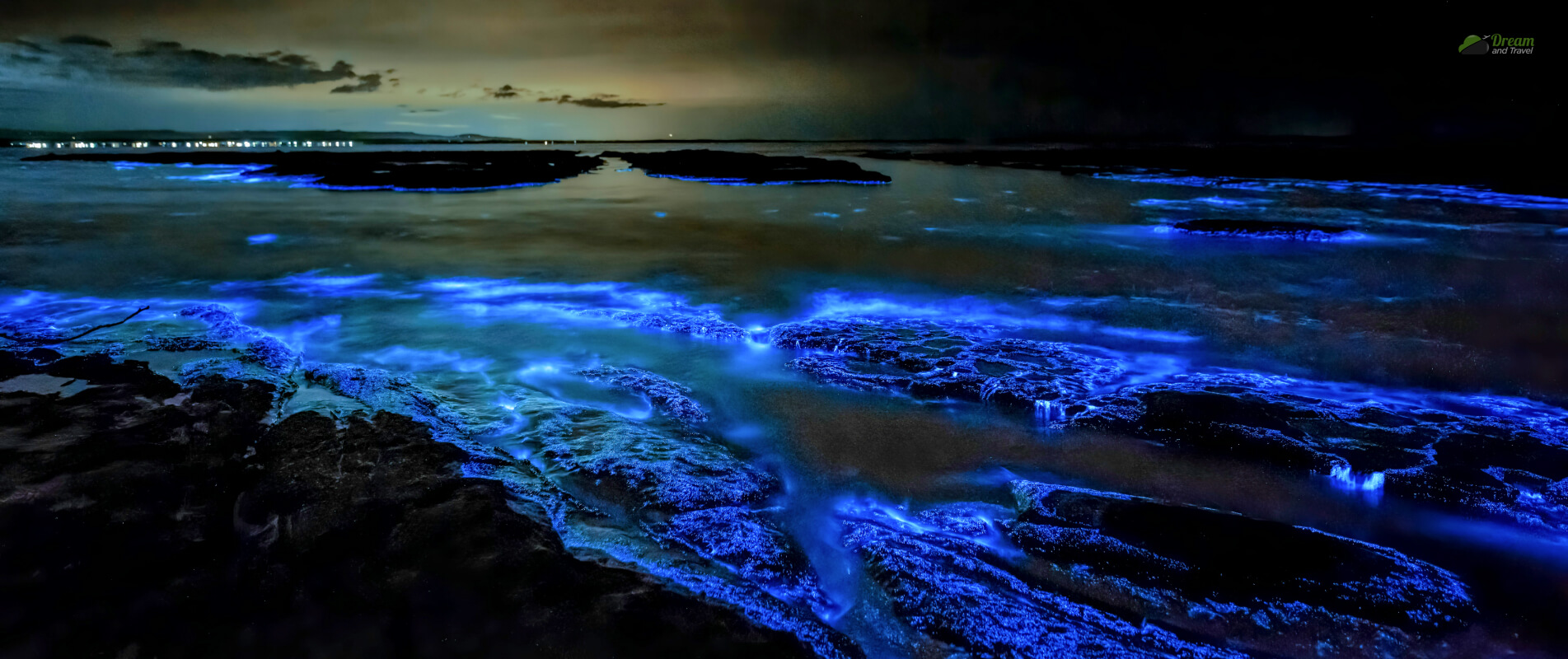A few hours ago, something on Yahoo! News caught my attention. Magical photos of bioluminescence near the Kynance Cove on the Lizard Peninsula. Richard Haynes has been the man behind the lens to capture this beautiful view in Cornwall County in England.
Such amazing photos! The bioluminescent planktons coming into life under a starlit sky is sheer magic. Do check the photos when you have the time.
Furthermore, more than 4000 miles away, Kutch in India, is gearing up to promote night coastal tourism. The Mandvi Region of Kutch, known for its bioluminescence sightings, will be the focus of this tourism development.
Also, for the last five years, night trekking from Mandvi to Naila has been a highlight of Kutch tourism in summer.
In the summer season, the temperature of the region drops dramatically at night, creating an ideal scenario for trekking and watching this wonderful natural phenomenon at the bioluminescence beach.
So, from the UK to India, bioluminescent beaches are making their presence felt in the beach tourism landscape of the world, expected to reach $364.95 billion by 2032, according to a report published on Coherent Market Insights.
What Is A Bioluminescence Beach?
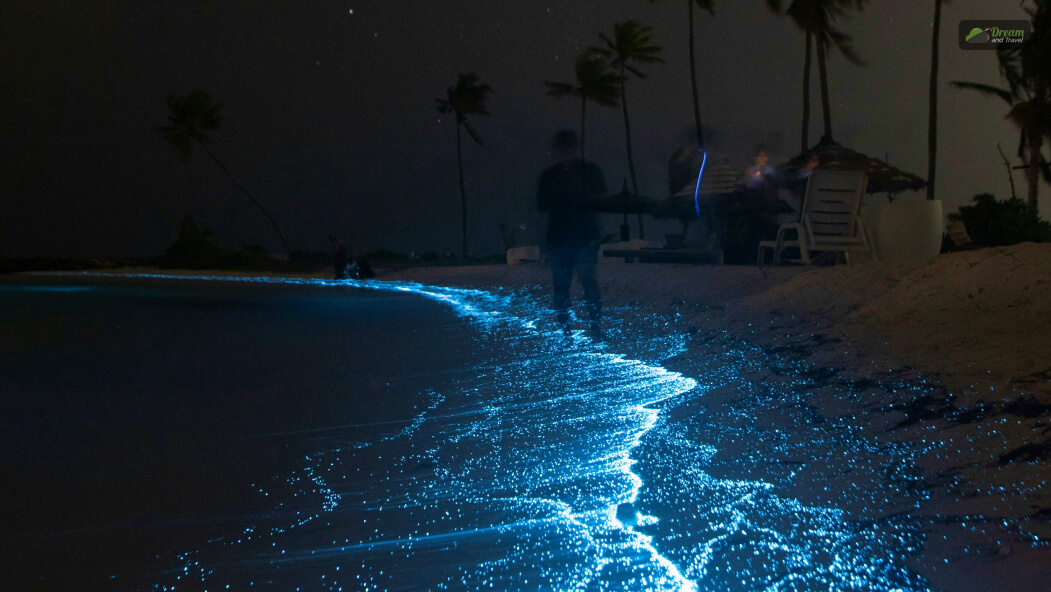
A bioluminescent beach is where you can see soft lights of neon blue in the water or on the shallow bay. However, in some scenarios, bioluminescence can be green or red in shade.
You can notice the billowing scene where the ocean is calm and warm. Furthermore, the water of the sea has to be nutrient-rich. Also, a windless condition is essential for the visibility of bioluminescence in the shallow bay or on the water surface.
This bioluminescence looks all the more appealing on a new moon night. Also, once the luminescent waves hit the shore, the bioluminescence remains on the shore for at least two nights.
Mosquito Bay in Puerto Rico is the most popular bioluminescent beach in the world.
Where Is There A Bioluminescent Beach? Why Do Some Beaches Glow At Night?

Now, the most fascinating part! What is the cause of bioluminescence at the beach?
Dinoflagellates, a type of bioluminescent phytoplankton, cause bioluminescence or glowing water in the marine ecosystem.
When these phytoplanktons promote the biochemical reaction that causes the bioluminescence, the same gets distributed in the water by the movement of a marine animal, agitated waves, or the movement of a boat.
To explain further, dinoflagellates emit luciferin boosted by the luciferase enzyme. Luciferin is a light-emitting molecule, and when it reacts with oxygen, it produces light.
This bioluminescence process is very crucial for the survival of these phytoplanktons and the marine ecosystem. Bioluminescence is often the medium of communication, camouflaging, and confusing predators.
Where Can I See Bioluminescent Beaches In The World?
From Japan to Puerto Rico, the bioluminescent beaches in the world are many. It’s time to relive your Life of Pi moments.
1. Mosquito Bay, Puerto Rico
Also known as the Bio Bay, Mosquito Bay is the brightest bioluminescent beach in the world according to the Guinness World Records.
It is a dolphin-shaped bay filled with mangrove trees, which protect the bioluminescence of the island.
Rowing here feels like gliding through a waterbody filled with blue stars. However, for a more immersive experience, you can take a ride in a glass-bottom kayak and get bathed in blue light.
2. Krabi, Thailand
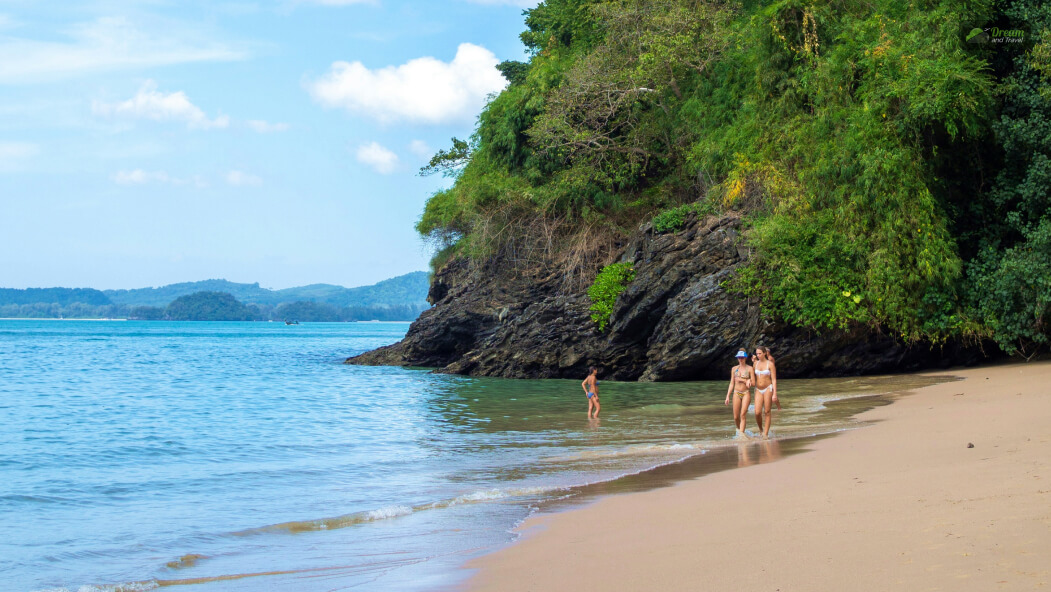
The Ton Sai beach in Krabi, Thailand, is a quiet retreat, and it is only accessible by boat rides and trekking. You will get the ferries from Phuket and Phi Phi Islands.
The planktons here reside in the deep water, and as you try walking through them, your feet will glow blue.
3. Matsu Islands, Taiwan
The main island of Nangan, Matsu Islands, or a group of islands in the East China Sea, gets its name from the statue of Mazu, the sea goddess in Taoism.
May to September is the best time to visit the Matsu Islands for bioluminescence. Locals refer to this bioluminescence as “blue tears.”
Even if you cannot see these “blue tears,” you can visit the Matsu Blue Tears Ecological Museum on Nangan Island. It is a place where algae are cultivated. So, you will see the phenomenon in a lab-like setup.
The hours of operation for this museum are 9:30 AM to 12 PM and then 1:30 PM to 5 PM. The contact number of the museum is +886 8 362 3338, and you must make prior reservations as there are specific slots for visitors in the morning, afternoon, and evening.
A guided tour of the museum will cost you NT$100.
4. Halong Bay, Vietnam
Halong Bay, ideal for a day trip from Hanoi, is a UNESCO World Heritage Site. It is located in northeast Vietnam, and overnight boating is a favorite outdoor activity here.
You can be a part of squid fishing in the fishermen’s boats, and as midnight falls, see the water turning blue with the bioluminescent algae sparkling.
5. Manasquan Beach, NJ
Manasquan Beach in New Jersey is a modest coastal community. Furthermore, it is a popular destination for water surfing and rafting.
The beach offers a spectacular bioluminescent view. On the other hand, at night, the water here looks red with the red algae floating in it.
6. Reethi Beach, Maldives
Reethi Beach in the Conrad Maldives Rangali Island of the Maldives looks stunning with bioluminescence at night.
The beach offers quite an adventure for the serious divers. It’s an experience to dive through the beams of neon blue light.
7. Vaadhoo Island, Maldives
Vaadhoo Island in Raa Atoll is also known as the Sea of Stars. Inhabited by fewer than 500 people, Vaadhoo Island is best visited from December to March.
In the late evening, you can take a stroll along the northern tip of the isle and notice the phytoplanktons transforming the sea and the bays into the “Sea of Stars.”
8. Toyama Bay, Japan
Toyama Bay in Japan is a bioluminescence beach that does not possess the bioluminescent feature due to phytoplankton.
This bay, located along the west coast of Japan, gets a handsome flow of firefly squid of mark hotaru-ika from March to May.
These squids live in the deep water of the V-shaped canyon during the daytime. In the evening, these squids come to the water surface for mating. Then, the photophores at the end of their tentacles light up.
9. Coles Bay, Tasmania, Australia
Tasmania has Coles Bay, Honeymoon Bay, and Wineglass Bay for spotting bioluminescent phytoplankton.
Coles Bay in the Freycinet National Park is our favorite among them. Take a three-hour drive from Hobart, and Coles Bay is the first to ban plastic shopping bags completely.
The Bay Area, in the shade of azure blue, the granite green mountains, and very low light pollution, make Coles Bay for spotting bioluminescence.
10. Koh Rong, Cambodia
Koh Rong is the filming location of Survivor. You will have to take a ferry ride from Sihanoukville to reach Koh Rong.
Koh Rong is pristine. So, there is very little light pollution, and on darker nights, you can see the sparkles of blue on white stretches of sand.
11. Padangbai, Bali
Padangbai is located at a distance of 1 hour from Denpasar, the capital of Bali. It is also the main ferry port for visiting the neighboring Lombok Island and other important ports of the country.
You can plan a night dive here to see the most magical bioluminescence.
Which Is The Best Bioluminescence Beach In India?
This post-monsoon season, the following bioluminescent beaches in India can be your go-to destination for some serious outdoor adventure and the most immersive experience.
1. Havelock Island Bioleminescence Beach In Andaman And Nicobar Islands
Best Time to Visit: October to May
Havelock Island, especially the Radha Nagar Beach, is one of the best beaches in Asia. It has beautiful nature trails for wildlife observation and trekking.
The white sand and turquoise water here become luminescent after Sundown.
2. Bangaram Island In Lakshadweep
Best Time to Visit: October to March
Bangaram Island has a distinct tear-drop shape. It has the most beautiful beaches and rich marine flora and fauna.
Thus, it is home to phytoplankton, which cause bioluminescence.
3. Betalbatim Beach In Goa
Best Time to Visit: November to February
Betalbatim Beach in Goa is famous for cleanliness and dolphin spotting. Furthermore, it has two other nearby beaches, like Majorda and Colva beaches.
4. Morjim Beach In Goa
Best Time to Visit: November to February
Morjim Beach is famous for hatching and nesting Olive Ridley turtles. These turtles are endangered.
You can also take part in watersports and have local cuisines at the beach shacks.
5. Thiruvanmiyur Beach In Tamil Nadu
Best Time to Visit: November to February
Thiruvanmiyur Beach is a quiet alternative to other Chennai beaches, such as Marina, which is also the longest beach in India.
It is a family-friendly beach, and Marundeeswarar Temple, an ancient temple dedicated to Lord Shiva, is a popular attraction here.
6. Juhu Biloluminescence Beach Mumbai
Best Time to Visit: October to March
Juhu Beach in Mumbai is best known for spotting Bollywood’s celebrities and the spicy snacks the beach stalls have to offer.
Visit the beach at night to see the bioluminescent water.
7. Kumbalangi Bioluminescence Beach In Kerala
Best Time to Visit: October to March
The sleepy fishing village of Kumbalangi comes to life when visitors flock to the Kumbalangi Beach. You can kayak through the backwaters here to see the water becoming luminescent with a glow of green and blue.
8. Kadalur Beach In Kozhikode, Kerala
Best Time to Visit: October to March
Kadalur Point Lighthouse, as a telltale of the early 20th century, stands proud on the Kadalur Beach along the Arabian Sea.
Furthermore, one of the longest beaches in the Coromandel Coast, Kadalur Beach has mild waves and is a popular spot for swimming.
9. Kudle Beach And Om Beach: Bioluminescence Beach In Gokarna
Best Time to Visit: October to March
Om Beach and Kudle Beach were the places I visited during my Hyderabad to Gokarna trip. Om Beach, a bioluminescent beach in Gokarna, gets its name from the unique “Om” shape.
Also, Om Beach is a hotspot for banana boat rides, parasailing, and jet ski rides.
On the other hand, Kudle Beach exudes a laid-back vibe, and it is known for Yoga retreats.
10. Kaup Beach, Karnataka
Best Time to Visit: Monsoon Months
Home to the historic Kaup Lighthouse, Kaup Beach is a popular destination for watching bioluminescence.
It has azure waters, and it looks beautiful with white sandy shores.
11. Bhangram Beach In Maharashtra
Best Time to Visit: March to October
Bhangram Beach is a less crowded bioluminescence beach. Visit the beach at night and take a stroll to see the neon blue light of the water.
12. Mattu Beach, Karnataka
- Best Time to Visit: June to September or the Monsoon Season
Mattu Beach, a serene beach in Karnataka, has a GI tag showing its cultural and natural significance. Along with being a bioluminescent beach in Karnataka, it is also known as the home to Mattu Gulla, or a special type of eggplant used in Udupi recipes.
Which Is The Best Time To See Bioluminescence On A Beach?

There are a lot of factors to consider when choosing the best time to visit bioluminescent beaches.
Have a look at the table below.
| Factors Impacting the Best Time to See Bioluminescent Beach | Best Time |
|---|---|
| Time of the Day | Usually the nighttime Especially between 10 AM and 2 PM |
| Water Conditions | Calm waves Warm water |
| Moon Phase | Moonless nights |
| Time of the Year | Post-monsoon months of June to September |
| Weather Conditions | Warm weatherClear weather conditions |
In this context, please remember that the best time to visit the beaches discussed and the best time to see bioluminescence will differ.
Can Weather Affect Bioluminescence Sightings?
Yes, weather can affect bioluminescence sightings. The best experience of bioluminescent sights is only possible when the phytoplankton are clustered on the water surface.
A heavy wind flow scatters the clusters. So, the intensity of bioluminescence goes down.
Also, while rainfall boosts algae blooms, heavy rainfalls make the water and the surroundings murky. So, there will be less visibility.
A high percentage of humidity in the air or a cloudy sky also makes bioluminescence in the water and on the beach less visible.
How To Enhance Your Experience At A Bioluminescence Beach?
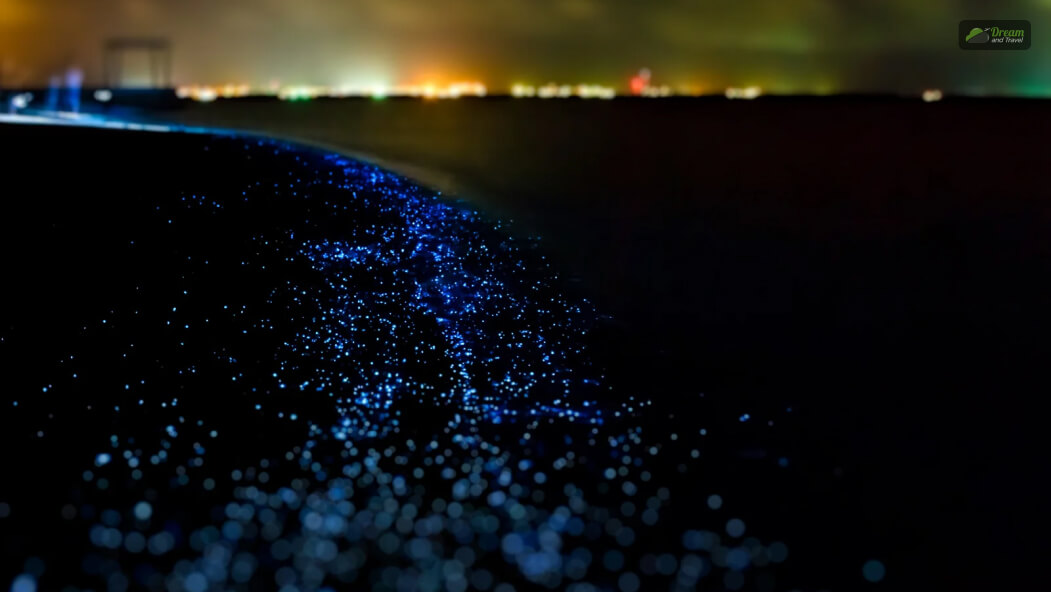
Follow these simple tips to enhance your experience at a bioluminescent beach.
- Beaches in remote locations have better bioluminescence visibility because of reduced light pollution.
- In most cases, a sensitive ecosystem grows around these waterbodies and beaches. So, you must follow the instructions of local guides and authorities to avoid disrupting the flora and fauna, and be familiar with them.
What Are The Ethical And Responsible Tourism Practices For Visiting A Bioluminescence Beach?
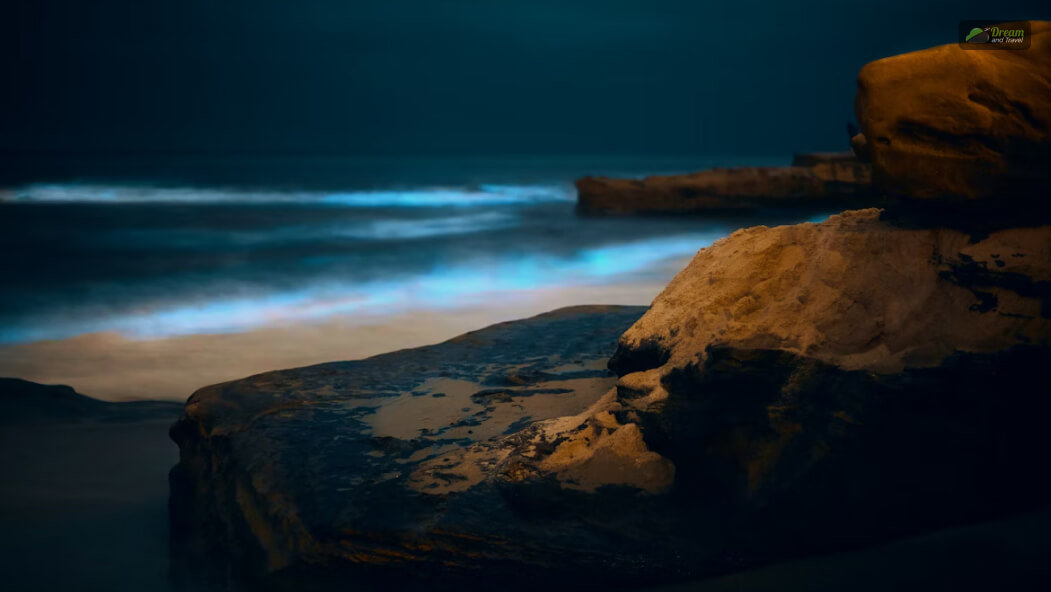
You must not use plastic bags or leave waste behind while visiting these beaches with bioluminescent properties.
Also, as mentioned earlier, it is important to respect the local wildlife. Moreover, you must follow the designated trails only for strolls and hikes around the sea beach.
Furthermore, follow the swimming restrictions and guidelines regarding the permitted beach activities.
Bioluminescence Beach: Frequently Asked Questions (FAQs)
Here are the frequently asked questions and answers about bioluminescent beaches.
Yes, you can swim in a bioluminescent beach. Bioluminescence is caused by phytoplankton and algal blooms, which are usually harmless.
However, some algal blooms can be allergic, and the local guidelines are the most important regarding the swimmability of the water in a bioluminescent sea. Sometimes, the seawater has other allergens, such as jellyfish.
Moreover, the intensity of the current in the water and other weather conditions at every beach will be different.
Also, in some beaches, like Mosquito Bay in Puerto Rico, swimming may be prohibited to protect the fragile ecosystem.
Bioluminescence, being a biochemical process, is not explicitly harmful to humans. However, jellyfish are also marine animals that cause bioluminescence, and they can cause allergic reactions.
Furthermore, dinoflagellates and some other types of bioluminescent algae can produce harmful toxins such as domoic acid and Saxitoxin. These toxins can cause health issues if they come in contact with human skin or are ingested.
Nausea, skin rashes, stomach issues, and allergic problems impacting the respiratory system are common health hazards of swimming in bioluminescent water.
Moreover, many marine animals eat the toxic algae. The toxins remain in their bodies, and when we consume those animals or seafood, the toxins reach our bodies.
No, you do not need special equipment to see bioluminescence. However, you can have the best experience of bioluminescence sightings by paddling or kayaking through the water.
However, to capture the photos of bioluminescence, you will need professional equipment.
Biloluminous waves can last a day or for several days. There are a lot of variables in determining how long the waves or the phytoplankton will last.
The availability of nutrients in the water, the type of algae causing the bioluminescence, the water temperature, and the predators in the water are major factors impacting the duration of bioluminescence.
Moreover, sometimes external aggressors and weather conditions impact the duration.
Nevertheless, in 2020, The Los Angeles Times reported the presence of bioluminescent waves for many weeks in Southern California.
Yes, you can take photos of bioluminescence. However, you will need professional equipment such as cameras with high ISO settings and fast lenses.
Tripods, remote shutters, and intervalometers are other equipment and accessories used to capture bioluminescence.
Smartphones are not ideal for capturing photos of bioluminescence.
